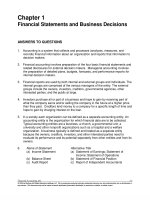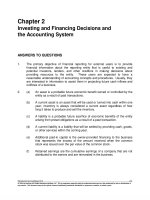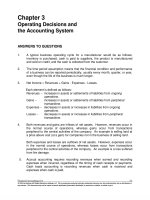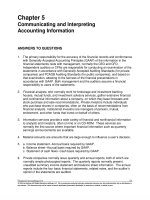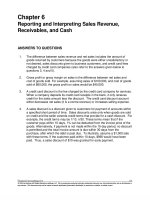Solution manual managerial accounting 8e by hansen mowen ch 7
Bạn đang xem bản rút gọn của tài liệu. Xem và tải ngay bản đầy đủ của tài liệu tại đây (248.31 KB, 42 trang )
To download more slides, ebook, solutions and test bank, visit
CHAPTER 7
SUPPORT-DEPARTMENT COST ALLOCATION
QUESTIONS FOR WRITING AND DISCUSSION
1. Stage one assigns support-department
costs to producing departments. Costs are
assigned using factors that reflect the consumption of the services by each producing
department. Stage two allocates the costs
assigned to the producing departments (including service costs and direct costs) to the
products passing through the producing departments.
2. Support-department costs are part of the
cost of producing a product. Knowing the individual product costs is helpful for developing bids and cost-plus prices.
3. GAAP require that all manufacturing costs
be assigned to products for inventory valuation.
4. Allocating support-department costs makes
users pay attention to the level of service activity consumed and also provides an incentive for them to monitor the efficiency of the
support departments.
5. Without
any
allocation
of
supportdepartment costs, users may view services
as a free good and consume more of the
service than is optimal. Allocating supportdepartment costs would encourage managers to use the service until such time as the
marginal cost of the service is equal to the
marginal benefit.
6. Since the user departments are charged for
the services provided, they will monitor the
performance of the support department. If
the service can be obtained more cheaply
externally, then the user departments will be
likely to point this out to management.
Knowing this, a manager of a support department will exert effort to maintain a competitive level of service.
7. The identification and use of causal factors
ensures that support-department costs are
accurately assigned to users. This increases
the legitimacy of the control function and
enhances product costing accuracy.
8. a. Number of employees; b. Square footage; c. Pounds of laundry; d. Orders
processed; e. Maintenance hours worked; f.
Number of employees; and g. Number of
transactions processed.
189
9. Allocating actual costs passes on the efficiencies or inefficiencies of the support department, something which the manager of
the producing department cannot control. Allocating budgeted costs avoids this problem.
10. The direct method allocates the direct costs
of each support department directly to the
producing departments. No consideration is
given to the fact that other support departments may use services. The sequential
method allocates support-department costs
sequentially. First, the costs of the center
providing the greatest service to all user departments, including other support departments, are allocated. Next the costs of the
second greatest provider of services are allocated to all user departments, excluding
any department(s) that has already allocated
costs. This continues until all supportdepartment costs have been allocated. The
principal difference in the two methods is the
fact that the sequential method considers
some interactions among support departments and the direct method ignores interactions.
11. Yes, the reciprocal method is more accurate
because it fully considers interactions
among support departments. However, the
reciprocal method is much more complex
and can be difficult for managers to understand. If the results are similar, the simpler
method should be used.
12. A joint cost is a cost incurred in the simultaneous production of two or more products.
At least one of these joint products must be
a main product. It is possible for the joint
production process to produce a product of
relatively little sales value relative to the
main product(s); this product is known as a
by-product.
13.
Joint costs occur only in cases of joint production. A joint cost is a common cost, but a
common cost is not necessarily a joint cost.
Many overhead costs are common to the
products manufactured in a factory but do
not signify a joint production process.
To download more slides, ebook, solutions and test bank, visit
EXERCISES
7–1
a.
b.
c.
d.
e.
f.
g.
h.
support
support
producing
producing
support
support
producing
producing
i.
j.
k.
l.
m.
n.
o.
support
support
producing
support
producing
support
support
support
support
support
support
support
producing
producing
support
i.
j.
k.
l.
m.
n.
o.
support
producing
producing
support
support
support
support
7–2
a.
b.
c.
d.
e.
f.
g.
h.
7–3
a.
direct labor hours;
number of employees
b. number of processing hours
c. labor hours; units produced
d. number of orders;
materials cost
e. materials cost;
orders received
f. orders shipped
g. number of employees
h.
i.
j.
k.
square feet
square feet
kilowatt-hours
number of employees;
direct labor cost
l. square feet
m. machine hours;
number of repair jobs
n. cubic feet
190
To download more slides, ebook, solutions and test bank, visit
7–4
1.
Charging rate = ($80 × 100 hours)/400 units = $20 per apartment unit
2.
Amount charged = ($80 × 130 hours) = $10,400
Amount actually charged apartment building owners:
3.
The Roost
Magnolia House
Oak Park
Wisteria Lane
Elm Street
Total
Number of
Units
130
70
120
50
30
400
The Roost
Magnolia House
Oak Park
Wisteria Lane
Elm Street
Total
Number of
Hours
35
10
45
15
25
130
×
×
Charge
per Unit
$20
20
20
20
20
Charge
per Hour
$80
80
80
80
80
=
=
Total
Charges
$ 2,600
1,400
2,400
1,000
600
$ 8,000
Total
Charges
$ 2,800
800
3,600
1,200
2,000
$ 10,400
The use of number of legal hours as the charging base is much better than the
number of apartment units. The number of legal hours is directly associated with
the attorney’s charges. The number of units is, apparently, a poor proxy for the
use of legal services. Two problems are immediately evident. First, the use of the
unit charge means that Stewart will only be charging actual legal fees when the
number of units times the per-unit rate happens to equal the number of hours
times the per-hour rate. In this case, he will not recoup all of his spending on legal fees. That occurred here, where Stewart charged the owners only $8,000 for
legal fees, but paid the attorney $10,400. In other years, the amount charged the
apartment owners will be more than the amount charged by the attorney. Second,
it is possible for apartment owners to have a smaller or larger proportion of units
than of hours. Even in the example above, we can see that Elm Street has a small
percentage of units, but causes a larger proportion of legal fees.
191
To download more slides, ebook, solutions and test bank, visit
7–5
1.
Single charging rate = ($320,000 + $400,000)/24,000 = $30/DLH
2.
Charge to the Used Car Sales Dept. = $517 + ($30 × 12 DLH) = $877
3.
DM
=
Actual DLH × Charging Rate +
New Car Sales
1,000
$30
$ 3,100
Used Car Sales
4,700
30
7,860
Service
19,400
30
86,300
Total
25,100
$97,260
Total Charges
$ 33,100
148,860
668,300
$850,260
7–6
1. Billing rate for maintenance = $193,200/4,200 = $46/maintenance hour
2. $46 × 370 = $17,020
3.
Total charged ($46 × 4,110)
Actual cost
Maintenance cost undercharged
$ 189,060
190,060
$ 1,000
192
To download more slides, ebook, solutions and test bank, visit
7–7
1.
$460 = $46 × number of hours of maintenance
Number of hours of maintenance = 10 hours
The controller must have looked up the usage of maintenance by the Assembly
Department, found that it had used 10 hours, and multiplied those hours by the
single charging rate of $46. In that case, $460 would be correct.
2.
Rate for routine maintenance = $48,000/2,000 = $24/routine maint. hour
Rate for technical maintenance = $145,200/2,200 = $66/tech. maint. hour
New charge for Assembly Department = $24 × 10 routine hours = $240
3.
When single charging rates are used by companies, they must be aware that
changes in the way work is performed may require changes in the charging
rate(s). In this case, the additional complexity caused by the computer-controlled
equipment means that a single charging rate does not adequately control for the
differences in cost caused by different departments. Multiple charging rates do a
better job of charging the using department for the resources provided by the
support departments.
193
To download more slides, ebook, solutions and test bank, visit
7–8
1.
Allocation ratios for S1 based on number of employees:
Cutting = 120/(120 + 80) = 0.60
Sewing = 80/(120 + 80) = 0.40
Allocation ratios for S2 based on number of maintenance hours:
Cutting = 15,000/(15,000 + 5,000) = 0.75
Sewing = 5,000/(15,000 + 5,000) = 0.25
2.
Direct costs
Allocate:
S1 (200,000)
S2
Total
Support Departments
S1
S2
$200,000 $ 140,000
—
—
$
0
120,000
(140,000)
$
0
Producing Departments
Cutting
Sewing
$ 122,000
$ 90,500
80,000
105,000
$ 347,000
35,000
$ 205,500
7–9
1.
Allocation ratios for S1 based on number of employees:
S2
= 50/(50 + 120 + 80) = 0.20
Cutting = 120/(50 + 120 + 80) = 0.48
Sewing = 80/(50 + 120 + 80) = 0.32
Allocation ratios for S2 based on number of maintenance hours:
Cutting = 15,000/(15,000 + 5,000) = 0.75
Sewing = 5,000/(15,000 + 5,000) = 0.25
2.
Direct costs
Allocate:S1
S2
Total
Support Departments
S1
S2
$ 200,000 $ 140,000
(200,000)
40,000
—
(180,000)
0
$
0 $
194
Producing Departments
Cutting
Sewing
$ 122,000
$ 90,500
96,000
64,000
135,000
45,000
$ 353,000
$ 199,500
To download more slides, ebook, solutions and test bank, visit
7–10
1.
Allocation ratios:
Proportion of Output Used by Department
S2
Cutting
Sewing
S1
—
0.2000
0.4800
0.3200
0.0566
—
0.7075
0.2358
S1
S2
2.
S1 =
S1 =
S2 =
S2 =
S2 =
S2 =
0.9887S2 =
S2 =
Direct costs + Share of S2 costs
$200,000 + 0.0566(S2)
Direct costs + Share of S1 costs
$140,000 + 0.200(S1)
$140,000 + 0.200 [$200,000 + 0.0566(S2)]
$140,000 + $40,000 + 0.0113(S2)
$180,000
$182,057
Substituting $180,057 for S2 into the S1 equation yields total S1 cost:
S1 = $200,000 + 0.0566($182,057)
= $200,000 + $10,304 = $210,304
3.
Direct costs
Allocated from:
S1
S2
Total
Support Departments
S1
S2
$200,000
$140,000
Producing Departments
Cutting
Sewing
$122,000
$ 90,500
(210,304)
10,304
$
0
100,946
128,805
$351,751
*Difference due to rounding.
195
42,061
(182,057)
$
(4)*
67,297
42,929
$200,726
To download more slides, ebook, solutions and test bank, visit
7–11
1.
Baking Dept. overhead rate = $150,000/6,250 = $24 per MHr
Decorating Dept. overhead rate = $42,000/6,000 = $7 per DLH
2.
Cost per batch:
Direct materials
Direct labor
Overhead:
Baking Dept. (2 × $24)
Total
$55
42
48
$145
Cost per loaf = $145/100 = $1.45
3.
Cost of Dearman wedding cake:
Direct materials
Direct labor
Overhead:
Baking Dept. (1 × $24)
Decorating Dept. (8 × $7)
Total cost
$ 20
50
24
56
$150
Price = 3 × $150 = $450
196
To download more slides, ebook, solutions and test bank, visit
7–12
1.
Allocation ratios:
Firing
0.80
0.25
0.29
Shaping
0.20
0.75
0.71
1
Kilowatt-hours
Square feet2
Direct labor hours3
1
based on kilowatt hours: 20,000/(20,000+80,000); 80,000/(20,000+80,000)
based on square feet: 24,000/(24,000+8,000); 8,000/(24,000+8,000)
3
based on direct labor hours: 10,000/(10,000+4,000);
4,000/(10,000+4,000)
2
Cost assignment:
Power Gen. Factory
HR
$90,000 $$167,000 $84,000
Direct overhead costs
Allocate:
Power
($90,000)
General Factory
Human Resources
Total after allocation
$0
2.
(167,000)
$0
Departmental overhead rates:
Shaping: $274,890/10,000 = $27.49 per DLH*
Firing: $368,110/4,000 = $92.03 per DLH*
*Rounded
197
Shaping
$72,000
Firing
$230,000
18,000
- 125,250
84,000
59,640
$0 $274,890
72,000
41,750
24,360
$368,110
To download more slides, ebook, solutions and test bank, visit
7–13
1.
Assume the support-department costs are allocated in order of highest to lowest
cost: General Factory, Power, and Human Resources.
Square feet
Kilowatt-hours
Labor hours
Power
0.05
—
—
GF
—
—
—
Direct costs
$ 90,000 $167,000
1
General Factory :
(0.05 × $167,000)
8,350
(8,350)
(0.15 × $167,000)
(25,050)
(0.60 × $167,000)
(100,200)
(0.20 × $167,000)
(33,400)
Power2:
(0.20 × $98,350)
(19,670)
(0.16 × $98,350)
(15,736)
(0.64 × $98,350)
(62,944)
Human Resources:
(0.71 × $128,720)
(0.29 × $128,720)
Total
$
0 $
0
1
based on square feet:
Power = 2,000/(2,000+6,000+24,000+8,000)
HR = 6,000/(2,000+6,000+24,000+8,000)
Shaping = 24,000/(2,000+6,000+24,000+8,000)
Firing = 8,000/(2,000+6,000+24,000+8,000)
2
based on kilowatt hours :
HR = 25,000/(25,000+20,000+80,000)
Shaping = 20,000/(25,000+20,000+80,000)
Firing = 80,000/(25,000+20,000+80,000)
HR
0.15
0.20
—
Shaping
0.60
0.16
0.71
Firing
0.20
0.64
0.29
$84,000
$ 72,000
$230,000
25,050
100,200
33,400
19,670
15,736
62,944
(91,391)
91,391
(37,329)
$
0 $279,327
Allocation Ratios for HR department based on direct labor hours :
Shaping
10,000/(10,000+4,000)
Firing
4,000/(10,000+4,000)
2.
Shaping: $279,327/10,000 = $27.93 per DLH*
Firing: $403,576/4,000 = $90.92 per DLH*
*Rounded
198
37,329
$363,673
To download more slides, ebook, solutions and test bank, visit
7-14
Andol
Incol
Ordol
Exsol
Total
Units
1,000
1,500
2,500
3,000
8,000
Percent ×
0.1250
0.1875
0.3125
0.3750
Joint Cost
$100,000
100,000
100,000
100,000
=
Allocated Joint Cost
$12,500
18,750
31,250
37,500
$100,000
7-15
Andol
Incol
Ordol
Exsol
Total
Units
1,000
1,500
2,500
3,000
8,000
Price at
Split-off
$20.00
75.00
64.00
22.50
7-16
1.
Ups
Downs
Total
Units
39,000
21,000
Price
$2.00
2.18
Market Value
at Split-off
$ 20,000
112,500
160,000
67,500
$360,000
Joint
Allocated
Percent
Cost
Cost
0.0556 $100,000
$ 5,560
0.3125
100,000
31,250
0.4444
100,000
44,440
0.1875
100,000
18,750
$100,000
Eventual
Separable
Market Value
Costs
$78,000
$18,000
45,780
5,780
Joint cost
× Percent of hypothetical market value
Allocated joint cost
Hypothetical
Market Value
$60,000
40,000
$100,000
Ups
$42,000
× 0.60
$25,200
2. Value of ups at split-off (39,000 × $1.80)
$70,200
Value of ups when processed further
Less: Further processing cost
Incremental value of further processing
$78,000
18,000
$60,000
Percent
0.60
0.40
Downs
$42,000
× 0.40
$16,800
Ups should NOT be processed further as there will $10,200 more profit if sold at splitoff.
199
To download more slides, ebook, solutions and test bank, visit
7–17
1.
1
HR
Power2
HR
—
0.0769
Power
0.3000
—
Mixing
0.3500
0.2308
Packaging
0.3500
0.6923
1
based on payroll:
90,000/(90,000+105,000+105,000)
105,000/(90,000+105,000+105,000)
105,000/(90,000+105,000+105,000)
2
based on kilowatt hours:
5,000/(5,000+15,000+45,000)
15,000/(5,000+15,000+45,000)
45,000/(5,000+15,000+45,000)
P = $150,000 + 0.3HR
P = $150,000 + 0.3($110,000 + 0.0769P)
P = $150,000 + $33,000 + 0.0231P
0.9769P = $183,000
P = $187,327
HR =
HR =
HR =
HR =
$110,000 + 0.0769P
$110,000 + 0.0769($187,327)
$110,000 + $14,405
$124,405
Human
Resources
Power
Direct overhead costs
$110,000
$150,000
Allocated from:
HR
(124,405)
37,321
Power
14,409
(187,327)
Total
$
0
$
(5)*
*Difference due to rounding.
2.
Mixing: $186,777/20,000 = $9.34 per DLH
Packaging: $453,228/30,000 = $15.11 per DLH
200
Mixing
$100,000
Packaging
$280,000
43,542
43,235
$186,777
43,542
129,686
$453,228
To download more slides, ebook, solutions and test bank, visit
7–18
1.
Direct overhead
Allocate HR1
Allocate Power
Total
1
2.
Support Departments
HR
Power
$110,000 $150,000
(110,000)
- (150,000)
$
0
$
0
Producing Departments
Mixing
Packaging
$100,000
$280,000
55,000
55,000
37,500
112,500
$192,500
$447,500
based on payroll:
Mixing = 105,000/(105,000+105,000) = 0.50
Packaging = 105,000/(105,000+105,000) = 0.50
2
based on kilowatt hours:
Mixing = 15,000/(15,000+45,000) = 0.25
Packaging = 45,000/(15,000+45,000) = 0.75
Mixing: $192,500/20,000 = $9.63 per DLH
Packaging: $447,500/30,000 = $14.92 per DLH
The reciprocal method is more accurate because support-department costs are
allocated to other support departments. Using the direct method, Human Resources and Power do not receive any other support department costs. How important the increased accuracy is for this example is not clear. Some might argue
that the departmental rates do not differ enough to justify using the more complicated reciprocal method.
201
To download more slides, ebook, solutions and test bank, visit
7–19
1.
Direct overhead
Allocate HR1
Allocate Power2
Total
1
2.
Support Departments
HR
Power
$110,000 $150,000
(110,000)
33,000
- (183,000)
$
0
$
0
Producing Departments
Mixing
Packaging
$100,000
$280,000
38,500
38,500
45,750
137,250
$184,250
$455,750
based on payroll:
Power = 90,000/(90,000+105,000+105,000) = 0.30
Mixing = 105,000/(90,000 + 105,000+105,000) = 0.35
Packaging = 105,000/(90,000 + 105,000+105,000) = 0.35
2
based on kilowatt hours:
Mixing = 15,000/(15,000+45,000) = 0.25
Packaging = 45,000/(15,000+45,000) = 0.75
Mixing: $184,250/20,000 = $9.21 per DLH
Packaging: $455,750/30,000 = $15.19 per DLH
The sequential method is more accurate than the direct method and less accurate
than the reciprocal method. The reason is that at least some support-department
reciprocity is accounted for using the sequential method, while none is recognized under the direct method.
202
To download more slides, ebook, solutions and test bank, visit
7–20
A = $35,000 + 0.3B
B = $40,000 + 0.2A
A=
A=
0.94A =
A=
$35,000 + 0.3($40,000 + 0.2A)
$47,000 + 0.06A
$47,000
$50,000
B = $40,000 + 0.2($50,000)
B = $50,000
Allocation ratios (ratios for D obtained by “plugging”):
Dept. A
Dept. B
*(1.0 – 0.2 – 0.2)
**(1.0 – 0.3 – 0.4)
Dept. A
—
0.3
Dept. B
0.2
—
Allocate A:
(0.2 × $50,000)
(0.6 × $50,000)
Allocate B:
(0.4 × $50,000)
(0.3 × $50,000)
Dept. C
0.2
0.4
Dept. D
0.6*
0.3**
Dept. C
Dept. D
$10,000
$30,000
20,000
15,000
203
To download more slides, ebook, solutions and test bank, visit
7–21
1.
General
Factory
$ 230,000
HR
Grinding
Assembly
Direct costs
$ 70,000
$ 63,900
$ 39,500
Allocate:
HR 1
(70,000)
—
14,000
56,000
Gen. Factory2
—
(230,000)
57,500
172,500
Total OH
$
0
$
0
$135,400
$268,000
1
based on payroll: 20,000/(20,000+80,000)=20%; 80,000/(20,000+80,000)=80%
2
based on square feet: 2,000/(2,000+6,000)=25%; 6,000/(2,000+6,000)=75%
2.
Grinding OH rate: $135,400/4,000 = $33.85 per MHr
Assembly OH rate: $268,000/80,000 = $3.35 per DLH
3.
Prime costs
Grinding (1 × $33.85)
Assembly (12 × $3.35)
Unit product cost
$123.00
33.85
40.20
$197.05
7–22
1.
General
Factory
$ 230,000
HR
$ 70,000
Direct costs
Allocate:
Gen. Factory1
76,667
(230,000)
HR 2
(146,667)
—
$
0
Total OH
$
0
1
HR = 4,000/(4,000+2,000+6,000)=33.33%
Grinding = 2,000/(4,000+2,000+6,000)=16.67%
Assembly = 6,000/(4,000+2,000+6,000)=50%
2
Grinding = 20,000/(20,000+80,000)=20%
Assembly = 80,000/(20,000+80,000)=80%
Grinding
$ 63,900
Assembly
$ 39,500
38,333
29,333
$131,566
115,000
117,334
$271,834
2.
Grinding OH rate: $131,566/4,000 = $32.89 per MHr (rounded)
Assembly OH rate: $271,834/80,000 = $3.40 per DLH (rounded)
3.
Prime cost
$123.00
Grinding (1 × $32.89)
Assembly (12 × $3.40)
Unit product cost
32.89
40.80
$196.69
7–23
204
To download more slides, ebook, solutions and test bank, visit
1.
HR
0.3333
GF-square feet1
HR-direct labor hrs2
—
GF
—
0.0991
Grinding
0.1667
0.1802
Assembly
0.5000
0.7207
1
HR: 4,000/(4,000+2,000+6,000) = 0.3333
Grinding: 2,000/(4,000+2,000+6,000) = 0.1667
Assembly: 6,000/(4,000+2,000+6,000) = 0.5000
2
Allocation ratios for HR based on payroll :
General Factory: 11,000/(11,000+20,000+80,000) = 0.0991
Grinding: 20,000/(11,000+20,000+80,000) = 0.1802
Assembly: 80,000/(11,000+20,000+80,000) = 0.7207
HR = $70,000 + 0.3333GF
GF = $230,000 + 0.0991HR
GF = $230,000 + 0.0991($70,000 + 0.3333GF)
0.967GF = $236,937
GF = $245,023
HR = $70,000 + 0.3333GF
HR = $70,000 + 0.3333($245,023)
HR = $151,666
Direct costs
Allocate:
HR
GF
Total OH
HR
$ 70,000
General
Factory
$ 230,000
Grinding
$ 63,900
Assembly
$ 39,500
(151,666)
81,666
$
0
15,030
(245,023)
$
7*
27,330
40,845
$132,075
109,306
122,512
$271,318
*Difference due to rounding.
2.
Grinding OH rate: $132,075/4,000 = $33.02 per MHr*
Assembly OH rate: $271,318/80,000 = $3.39 per DLH*
*Rounded
3.
Prime costs
Grinding (1 × $33.02)
Assembly (12 × $3.39)
Unit product cost
$123.00
33.02
40.68
$196.70
205
To download more slides, ebook, solutions and test bank, visit
7–24
1.
Alpha
Beta
Gamma
Total
Units
12,500
17,500
20,000
50,000
Percent ×
0.25
0.35
0.40
Joint Cost
$125,000
125,000
125,000
=
Allocated Joint Cost
$31,250
43,750
50,000
$125,000
2.
Alpha
Beta
Gamma
Total
Units
12,500
17,500
20,000
50,000
Price at
Split-off
$20
50
18
Market Value
at Split-off
$ 250,000
875,000
360,000
$1,485,000
206
Joint
Percent
Cost
0.1684 $125,000
0.5892
125,000
0.2424
125,000
Allocated
Cost
$ 21,050
73,650
30,300
$125,000
To download more slides, ebook, solutions and test bank, visit
PROBLEMS
7–25
1.
Direct method:
Direct costs
Allocate:
Delivery1
Accounting2
Total
Delivery
$240,000
(240,000)
-$
0
Accounting Laboratory
$270,000
$345,000
-(270,000)
$
0
144,000
175,500
$664,500
Tissue
Pathology
$456,000
96,000
94,500
$646,500
1
Laboratory: 70,200/(70,200+46,800) = 0.60
Tissue Pathology: 46,800/(70,200+46,800) = 0.40
2
Laboratory: 24,700/(24,700+13,300) = 0.65
Tissue Pathology: 1,3,300/(24,700+13,300) = 0.35
2.
Sequential method
Direct costs
Allocate:
Accounting1
Delivery2
Total
Delivery
$ 240,000
Accounting
$ 270,000
Laboratory
$345,000
Tissue
Pathology
$456,000
13,500
(253,500)
$
0
(270,000)
0
$
0
166,725
152,100
$663,825
89,775
101,400
$647,175
1
Delivery: 2,000/(2,000+24,700+13,300) = 0.050
Laboratory: 24,700/(2,000+24,700+13,300) = 0.6175
Tissue Pathology: 13,300/(2,000+24,700+13,300) = 0.3325
2
Laboratory: 70,200/(70,200+46,800) = 0.60
Tissue Pathology: 46,800/(70,200+46,800) = 0.40
207
To download more slides, ebook, solutions and test bank, visit
7–26
1.
a. Direct method
Maintenance
$320,000
Power
$400,000
Direct costs
Allocate:
Maintenance1
(320,000)
0
2
Power
0
(400,000)
Total
$
0
$
0
1
Drilling: 30,000/(30,000+7.500) = 0.80
Assembly: 7,500/(30,000+7,500) = 0.20
2
Drilling: 36,000/(36,000+324,000) = 0.10
Assembly: 324,000/(36,000+324,000) = 0.90
Drilling: $459,000/30,000 = $15.30 per MHr
Assembly: $514,000/40,000 = $12.85 per DLH
Prime costs
Drilling (2 × $15.30)
Assembly (50 × $12.85)
Total cost
Markup (15%)
Bid price
$1,817.00
30.60
642.50
$2,490.10
373.52
$2,863.62
208
Drilling
$163,000
Assembly
$ 90,000
256,000
40,000
$459,000
64,000
360,000
$514,000
To download more slides, ebook, solutions and test bank, visit
7–26
Continued
b. Reciprocal method
Maintenance
—
0.100
1
Machine hours
Kilowatt-hours2
Power
0.375
—
Drilling
0.500
0.090
Assembly
0.125
0.810
1
Power: 22,500/(22,500+30,000+7.500) = 0.375
Drilling: 30,000/(22,500+30,000+7.500) = 0.500
Assembly: 7,500/(22,500+30,000+7,500) = 0.125
2
Maintenance: 40,000/(40,000+36,000+324,000) = 0.100
Drilling: 36,000/(40,000+36,000+324,000) = 0.090
Assembly: 324,000/(40,000+36,000+324,000) = 0.810
M=
P=
M=
M=
0.9625M =
M=
P=
P=
P=
P=
$320,000 + 0.1P
$400,000 + 0.375M
$320,000 + 0.1($400,000 + 0.375M)
$320,000 + $40,000 + 0.0375M
$360,000
$374,026
$400,000 + 0.375M
$400,000 + 0.375($374,026)
$400,000 + $140,260
$540,260
Direct cost
Allocate:
Maintenance
Power
Total
Maintenance
$320,000
Power
$400,000
Drilling
$163,000
Assembly
$90,000
($374,026)
54,026
$
0
140,260
(540,260)
$
0
187,013
48,623
$398,636
46,753
437,611
$574,364
Drilling: $398,636/30,000 = $13.29 per MHr (rounded)
Assembly: $574,364/40,000 = $14.36 per DLH (rounded)
Prime costs
Drilling (2 × $13.29)
Assembly (50 × $14.36)
Total cost
Markup (15%)
Bid price
$1,817.00
26.58
718.00
$2,561.58
384.24
$2,945.82
2. The reciprocal method is more accurate, as it takes into account the use of
support departments by other support departments.
209
To download more slides, ebook, solutions and test bank, visit
7–27
1.
a. Sequential method: Allocate Maintenance first, then Power
Direct costs
Allocate:
Maintenance1
Power2
Total
Maintenance
$ 320,000
Power
$ 400,000
Drilling
$163,000
Assembly
$ 90,000
(320,000)
0
$
0
120,000
(520,000)
$
0
160,000
52,000
$375,000
40,000
468,000
$598,000
1
Power: 22,500/(22,500+30,000+7.500) = 0.375
Drilling: 30,000/(22,500+30,000+7.500) = 0.500
Assembly: 7,500/(22,500+30,000+7,500) = 0.125
2
Drilling: 36,000/(36,000+324,000) = 0.100
Assembly: 324,000/(36,000+324,000) = 0.900
Drilling: $375,000/30,000 = $12.50 per MHr
Assembly: $598,000/40,000 = $14.95 per DLH
Prime costs
Drilling (2 × $12.50)
Assembly (50 × $14.95)
Total cost
Markup (15%)
Bid price
$1,817.00
25.00
747.50
$2,589.50
388.43
$2,977.93
210
To download more slides, ebook, solutions and test bank, visit
7–27
Concluded
b. Sequential method: Allocate Power first, then Maintenance
Direct costs
Allocate:
Power1
Maintenance2
Total
Maintenance
$ 320,000
40,000
(360,000)
$
0
Power
$ 400,000
Drilling
$163,000
Assembly
$ 90,000
(400,000)
0
$
0
36,000
288,000
$487,000
324,000
72,000
$486,000
1
Maintenance: 40,000/(40,000+36,000+324,000) = 0.10
Drilling: 36,000/(40,000+36,000+324,000) = 0.09
Assembly: 324,000/(40,000+36,000+324,000) = 0.81
2
Drilling: 30,000/(30,000+7.500) = 0.80
Assembly: 7,500/(30,000+7,500) = 0.20
Drilling: $487,000/30,000 = $16.23 per MHr (rounded)
Assembly: $486,000/40,000 = $12.15 per DLH
Prime costs
Drilling (2 × $16.23)
Assembly (50 × $12.15)
Total cost
Markup (15%)
Bid price
2.
$1,817.00
32.46
607.50
$2,456.96
368.54
$2,825.50
Yes, there is a difference in the bids. Ranking Maintenance first results in a higher
dollar allocation to Power ($120,000) than the allocation from Power to Maintenance ($40,000). Then, the greater usage of Power by Assembly results in a higher
allocation to Assembly when Maintenance is ranked first. Thus, the ranking of
Maintenance first gives a greater chance for support-department interaction to be
reflected in the ultimate overhead rates. (These results can be compared with the
results using the reciprocal method in Problem 7–26.)
211
To download more slides, ebook, solutions and test bank, visit
7–28
1.
Two Oil
Six Oil
Distillates
Total
Units
300,000
240,000
120,000
660,000
Percent
0.4545
0.3636
0.1818
×
Joint Cost
$10,000,000
10,000,000
10,000,000
=
Allocated Joint Cost
$4,545,000
3,636,000
1,818,000
$9,999,000
2.
Units
Price at
Split-off
Market Value
at Split-off
300,000
$20
$6,000,000
Six Oil
240,000
Distillates 120,000
Total
660,000
30
15
7,200,000
1,800,000
$15,000,000
Two Oil
212
Percent
Joint
Cost
Allocated
Cost
0.4000 $10,000,000 $4,000,000
0.4800 10,000,000
0.1200 10,000,000
4,800,000
1,200,000
$10,000,000
To download more slides, ebook, solutions and test bank, visit
7–29
1.
Fixed cost allocation (direct method):
Cost driver
Employees1
Items processed2
Square feet3
Machine hours4
Mixing
0.400
0.329
0.444
0.200
1
Allocation Ratios
Cooking
Packaging
0.200
0.400
0.318
0.353
0.333
0.222
0.500
0.300
Mixing = 20/(20+10+20) = 0.40
Cooking = 10/(20+10+20) = 0.20
Packaging = 20/(20+10+20) = 0.40
2
Mixing = 2,800/(2,800+2,700+3,000) = 0.329
Cooking = 2,700/(2,800+2,700+3,000) = 0.318
Packaging = 3,000/(2,800+2,700+3,000) = 0.353
3
Mixing = 40,000/(40,000+30,000+20,000) = 0.444
Cooking = 30,000/(40,000+30,000+20,000) = 0.333
Packaging = 20,000/(40,000+30,000+20,000) = 0.222
4
Mixing = 4,000/(4,000+10,000+6,000) = 0.20
Cooking = 10,000/(4,000+10,000+6,000) = 0.50
Packaging = 6,000/(4,000+10,000+6,000) = 0.30
213




